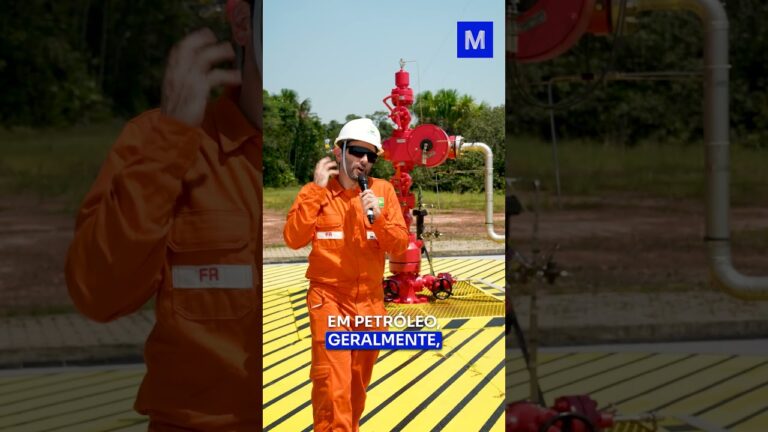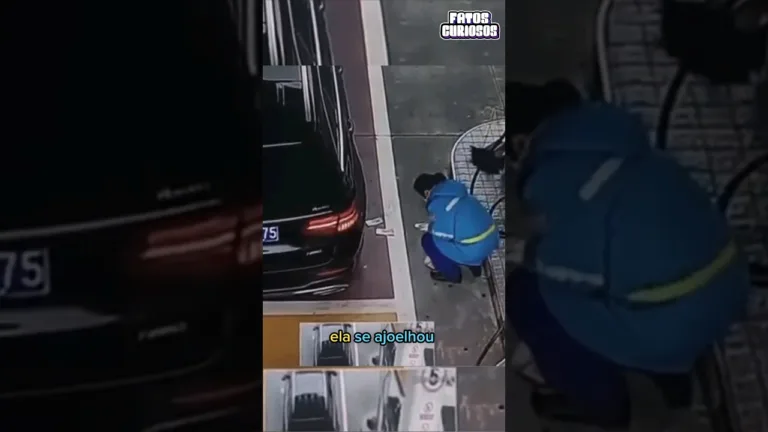CARRINHO movido a HIDROGÊNIO: nós TURBINAMOS!
One, two, three and… Today we are going to test a car powered by hydrogen. It's not like a car, a car, but it's a car. This weird little thing that just arrived from China, and it's a hydrogen-powered car, yes, it has a fuel cell. This fuel cell takes hydrogen, combines it with oxygen from the air, and generates electricity. Not only is it a hydrogen-powered car, but it's also an electric car. This car is simple. Here at the front, we're going to have a hydrogen generator. Here's the big secret. It will take the hydrogen, react it with the oxygen in the air, and get electrical energy from that. This electrical energy goes down to the engine that is down here, which manages to turn the two rear wheels. And of course like every car it came with its manual which, in this case, is in Chinese. Whole, long pages written in… I was going to speak Mandarin, but I don't even know if it's actually written in Mandarin. What I think is the coolest thing about this car, which I really wanted to see, is The fuel cell that takes hydrogen and transforms it into energy. But let's understand how such a thing is possible. Let's do the famous electrolysis here. We will break the water using electricity. In the water, there's a little bit of sodium bicarbonate, inside, two pencils, and These two pencils I'm going to connect to a 9 volt battery. I mean, if I can unravel that thread… Look at what will happen. One, two, three and… What is happening here is that We are taking the water molecule, which is H2O, and separating the hydrogen from the oxygen. So, on a pencil here, hydrogen gas is coming out, and on the other side, oxygen gas Is coming out. And it is very likely that you have already seen this experience In school. What almost nobody sees is that the opposite is also possible. We put in energy and managed to generate oxygen and hydrogen. Now, I can also take the oxygen and hydrogen that are in the water and generate energy. I choked! If you've never seen this before, I think that thumbs up in the video would be worth it, huh? I will confess that this is the first time I have seen this in 41 years of existence. Dude, generate electricity from water? Of course not… I'll say it again so we don't Forget: what is generating electricity is the gas that we managed to produce using Electricity itself. It's the little bubbles of oxygen and hydrogen that are there
At the tip of the pencil in the water. It's not the water itself, okay? So let's Do it again. I'm going to turn on the LED and then I'll slap the bubbles. You will see that the LED turns off. So, now we understand a little bit what is happening here in the fuel cell. It will take the hydrogen that comes from this reservoir, the oxygen that is in the Air, the two will react, they will form water and this chemical reaction releases a lot of energy. We will use this energy in the form of electricity. Looking closely, hydrogen enters here, oxygen will enter on the other side. You can see that there are two little metal plates that end here at these connection points. These flat irons work like those pencils. In one, there will be oxygen gas, and the Other flat iron will come into contact with hydrogen. In the middle of the plates, You can see that there is a black thing here, a membrane, which will act as if it Were water. What is very special about the fuel cell is that it manages to carry Out this chemical reaction very slowly to take advantage of the energy very little By little, because, normally, when we combine hydrogen with oxygen, which is burning Hydrogen, the reaction like that doesn't happen very slowly, no. Are you thinking The same thing I'm thinking? We're going to do a chemical reaction and I'm not going To tell you what it is now, it's going to be the same one we're going to do at the End of the video, okay? The important thing is that it generates a lot of hydrogen, which we will keep in this bladder. Yeah, one thing I hadn't told you yet is that hydrogen is much less dense than air And the bladder, theoretically, was supposed to fly if it was a little more full, it would fly. But I think from this size here we can already see its power. One, two, three and… We've messed up enough, let's get this cart working. Traditional Chinese to Portuguese. Hydrogen energy experiment. Google translator is pretty crazy… Inside the pot, I need to put these zinc balls that came with the cart. On top of them, there's Citric acid, which is a weak acid, there's not much danger of us dealing with it, And for the reaction to happen, we need water. But the detail is that this water Needs to be hot, at 80 degrees Celsius, otherwise everything will be very slow. And look how cool, this here are the hydrogen bubbles appearing. Back here there's a three-way switch. In the middle it is turned off. If I put it Over here and it lights up, it means that the electricity is already able to feed the LED. We have electricity! If I turn the other way, it turns on the car's ignition. I mean, ignition isn't the
Right word in this case, but anyway… it turns on the car's electric motor. Does this car here have the strength to drive? It's not light, no. Electric car powered by hydrogen. It's even smart and doesn't throw itself off the cliff… in this case it stopped Working because it didn't have the strength. Look, let's agree that it's not like That, you know, a F1 races car, but it's really crazy for us to think that this car Is being powered by hydrogen, which is being generated by a chemical reaction that Later transforms gas into electrical energy. Not very efficient… Let's measure how many volts the little bug is generating here. 934… 935 millivolts. That is, it doesn't even give a volt, that's why it's weak like that. But it is still off, the engine is off. If I connect it to the motor, this here will Probably fall, do you want to see? Look… 700 and something, 600… I think it's too weak because it generates too little hydrogen. We have better methods of generating hydrogen, by the way, this here is very different from what a real car would be, okay? We are not going to put zinc and citric acid in the car's tank so that it can drive Away. In general, when we think of hydrogen-powered cars, you have to load hydrogen Directly from the car and, inside, it will have a reservoir, there will not be a Chemical reaction that generates hydrogen at the time. And many people say that Hydrogen is the fuel of the future, because there is something really cool about The chemical reaction of burning hydrogen. In that explosion that we saw, this is what will happen… The hydrogen gas reacts with the oxygen gas and forms water. This means that the car's exhaust system burned hydrogen, carbon dioxide will not Come out, nothing polluting will come out. Only water will come out! Can you imagine How crazy it is for us to have cars in our city that, instead of releasing pollution, Release water vapor through the exhaust? It's all very beautiful if it weren't for One detail. Where does this hydrogen come from here? Where do we get hydrogen in nature? There is no easy way to produce hydrogen, here In the car, for example, we are using zinc and citric acid. Zinc you won't find In any corner. For you to produce zinc, it takes a lot of energy. It would be possible To generate hydrogen from a fossil fuel, for example, from methane, but then, we are not solving the problem either… A clean solution would be to generate what is called green hydrogen, which is breaking
Water with electrical energy, as we saw here at the beginning of the video, with Electrolysis, using electrical energy that comes from a clean source. How would The scheme look? We would have electricity from solar, wind or hydroelectric power. We use this energy in electrolysis, which breaks down the particles in the water, From there we take the hydrogen, and this hydrogen goes into the car. So, at the end of the day, you have a car that is being driven by the sun, wind or water. And then, yes, we have a car with clean energy, which does not pollute. But let's try to improve this car? I'm going to generate hydrogen in a different Way here that won't be this clean green hydrogen, no. It will be the same dirty Method, but with another metal. In place of the zinc pellets, I'm going to put these Magnesium shavings, on top of the citric acid and then a little water that doesn't even need to be hot. Look how much more hydrogen it generates than before. But there's one more difference. On the other side, I'll inject pure oxygen. I'm going to take hydrogen peroxide, which is ordinary water but with an extra oxygen Atom, and the person who will release this oxygen atom will be biological yeast. Yes, biological yeast releases oxygen from hydrogen peroxide. A little noise here that I don't know if you can hear it. Look at the oxygen forming… And now! LED on, it is generating power. Wow! It was a cart, now it's a carriage! It's even snoring now. If you haven't signed up yet for Manual do Mundo, sign up because this isn't the first cool thing we show you, ok? It explains why the manufacturer didn't put magnesium in the original. The chemical reaction is so hot, so exothermic, that it melts the plastic. I know you enjoyed seeing hydrogen exploding and wanted to see more. So, access the video we recorded about 10 years ago showing several hydrogen explosions In slow motion, including inside a watermelon.







